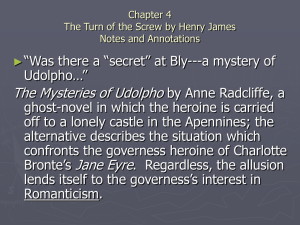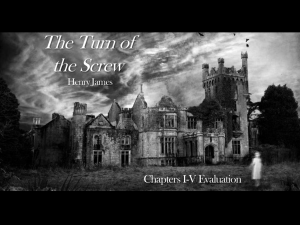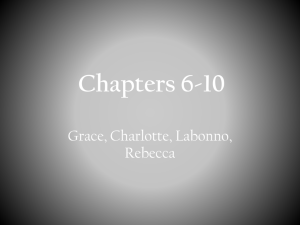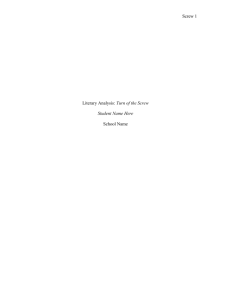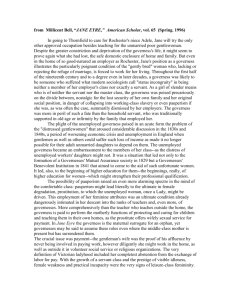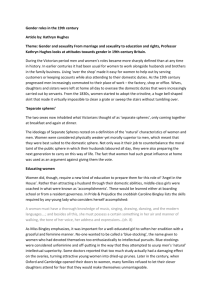PPRCrit Approaches 638 - Turn of the Screw - psychoanalysis.doc
advertisement
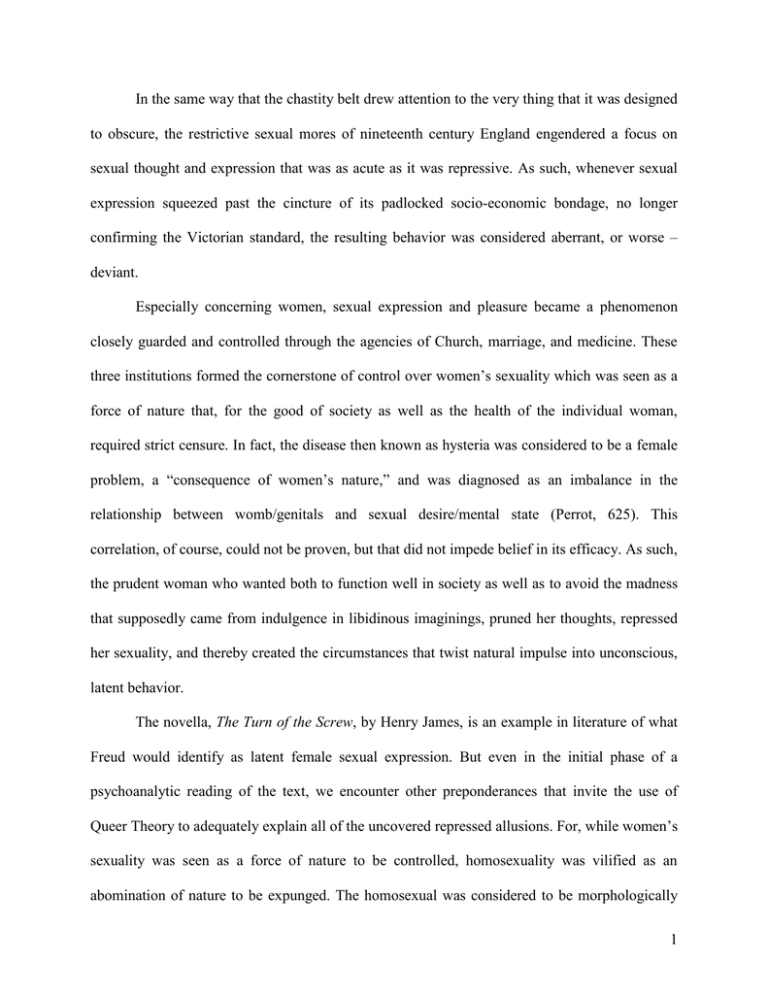
In the same way that the chastity belt drew attention to the very thing that it was designed to obscure, the restrictive sexual mores of nineteenth century England engendered a focus on sexual thought and expression that was as acute as it was repressive. As such, whenever sexual expression squeezed past the cincture of its padlocked socio-economic bondage, no longer confirming the Victorian standard, the resulting behavior was considered aberrant, or worse – deviant. Especially concerning women, sexual expression and pleasure became a phenomenon closely guarded and controlled through the agencies of Church, marriage, and medicine. These three institutions formed the cornerstone of control over women’s sexuality which was seen as a force of nature that, for the good of society as well as the health of the individual woman, required strict censure. In fact, the disease then known as hysteria was considered to be a female problem, a “consequence of women’s nature,” and was diagnosed as an imbalance in the relationship between womb/genitals and sexual desire/mental state (Perrot, 625). This correlation, of course, could not be proven, but that did not impede belief in its efficacy. As such, the prudent woman who wanted both to function well in society as well as to avoid the madness that supposedly came from indulgence in libidinous imaginings, pruned her thoughts, repressed her sexuality, and thereby created the circumstances that twist natural impulse into unconscious, latent behavior. The novella, The Turn of the Screw, by Henry James, is an example in literature of what Freud would identify as latent female sexual expression. But even in the initial phase of a psychoanalytic reading of the text, we encounter other preponderances that invite the use of Queer Theory to adequately explain all of the uncovered repressed allusions. For, while women’s sexuality was seen as a force of nature to be controlled, homosexuality was vilified as an abomination of nature to be expunged. The homosexual was considered to be morphologically 1 determined with physical characteristics identifying him as “a new kind of monster, an animal whose sexual activities resembled those of a dog” (Perrot, 640). Discovery of homosexual behavior, or even the mere accusation of such, often led to prison and/or social ostracism (Perrot, 642). As a result, during this era it was common practice to speak and write in euphemisms, to make allusion to sexual matters without directly identifying the topic. In this way, when a person wanted to communicate sexual meaning, he or she did so using coded language. The listener – or reader – who understood the coded context in this delicate use of language was “in the know.” But, if the listener/reader did not understand the coded meaning, then the communication would be considered exclusively for its obvious, superficial meaning behind which the speaker, having said nothing untoward on the surface, remained safe from discovery. When authors write in this manner, therefore, they have two audiences: a primary audience that perceives only the obvious meaning of the text, and a secondary audience that sees the same obvious meaning but also catches the presence of imbedded sexual content. It is my contention that Henry James intentionally employed this devise of hidden sexual allusion when he wrote The Turn of the Screw in 1897. This is a story whose manifest content, that of the ghost story popular at this time, conceals the latent content of both heterosexual and homosexual expression. In other words, the subtext of The Turn of the Screw is the sexual repression of both the main character, the Governess, and the author, Henry James. This analysis starts with the outer shell, the manifest or superficial text of “ghost story,” so that it can be peeled back to uncover the latent sexual material that James intends for his secondary audience. Excluding the prologue for the moment (to be taken up later in this discussion), we have the first hand account of a governess who has been given full charge of two children living at a large country estate called Bly. The Governess sees two ghosts, male and 2 female, identified as former employees of the estate, and she determines that these phantasms are bent on diabolical deeds concerning the children. The Governess attempts to prevent the ghosts from getting hold of the children, but, in the end, the male ghost, Quint, seems to have had the upper hand in this battle when the boy, Miles, dies in the arms of the Governess. What is not accounted for in this summation, however, is James’s elusive style in telling this tale. James leaves gaps in the text at the precise moments where information is most wanted. By doing this, he is not just building intrigue and suspense in the reader; he is inciting speculation. And the inferences he embroiders throughout the text’s plot and language foster speculation that his gaps are designed to highlight, by the very act of obscuring, the hidden sexual content. For example, there is never anything specifically stated about the ghost’s actual intentions with the children. However, there is always vague, but damning, innuendo about the relationship Quint and Miss Jessel – when living – had had with each other and with the children. Furthermore, the Governess’s private thoughts concerning the children and her employer, whom she calls “the master,” seem incredible and out of proportion to her actual relationship to them: she has deeply romantic fantasies about her employer, despite having met him briefly only twice, and she lavishes on the children an adoration that reads like the language of a lover caught up in full blown obsession. James acknowledged the oddity of his text when, “in speaking about “The Turn of the Screw” in the collected edition of his work, [he] . . . recalled telling himself ‘Only make the reader’s general vision of evil intense enough . . . and his sympathy (with the children) and horror (of their false friends) will supply them quite sufficiently with all the particulars’” (Lewis, xv). By this, James could be seen as presaging the Reader Response movement. It is much more likely that he is prompting his Victorian (and post-Victorian) readers to access, consciously, or unconsciously, their own unspoken knowledge of the unspoken subject of desire, 3 for what could be more evil in the nineteenth century than “the thing” that dare not be put into words. So, just beneath the manifest content of the ghost story, we discover the latent content of the Governess’s repressed sexuality. Using the first person narrative voice of his main character, James slowly, but steadily, exposes the inner workings of the Governess’s mind creating the impression of sexual repression. He then compounds this with the presence of the ghosts, for it is never clear whether they are real or imagined as the Governess is the only one who sees them. However, this very fact, her solitary experience of the “living detestable dangerous presence” of Quint and Miss Jessel, suggests her singular connection to them. Therefore, James’s secondary audience communication is made by inducing the reader to see the Governess’s sexual repression as (James, 1) an internal projection of intense affection by which she objectifies her male employer and his children, and (James, 2) an external projection, in the form of evil, homoerotic ghosts, representing her abhorrence for her own sensual nature. The Governess’s fascination with her employer begins at their first meeting and is later continued in her imagination. Her employer is described as “a bachelor in the prime of life . . . handsome, bold and pleasant, off-hand and gay and kind.” This is innocuous enough, until the description of him turns Romantic characterizing him in terms of the eternal: “such a figure had never risen, save in a dream or an old novel” (James, 7). And the Governess, standing alone in the presence of this exaggerated specimen of manhood, is alluded to in the metaphoric image of the “fluttered anxious girl out of a Hampshire vicarage,” evoking female innocence enforced via parochial chastity. In this way, womanhood is remanded to “girl”-hood and marked by the fluttering anxiety of sexual responsiveness being suffocated. The language describing her second and last meeting with “the master,” paints her as having “succumbed” to the “seduction exercised by the splendid young man,” as having “engaged” to take up his offer of employment, 4 and as having felt “already . . . rewarded” (James, 8 – 9) by his merely thanking her while holding her hand. There is a class distinction between them that presupposes the possibility of any marital engagement, but which does not prevent the young governess from fantasizing along lines of related romantic possibilities. She strolls the grounds “with a sense of property that amused and flattered” her such that it gave “pleasure – if he ever thought of it – to the person to whose pleasure [she] had yielded.” She even expects that her remarkable disposition “would more publicly appear” bringing her closer to his attention. From these thoughts she imagines a “charming story” in which her path leads her to “someone [who] would stand before [her] and smile and approve” (James, 19). Coupled with this thought, is the idea that “he should know” and that “the only way to be sure he knew would be to see it, and the kind light of it, in his handsome face.” It is at this moment that she sees the ghost, and, tellingly, she has “the sense that her imagination had . . . turned real” (James 19). In other words, this knowingness that she craves and fantasizes, with its secondary audience italicization, is now being projected into a three dimensional reality right in front of her, for in that first moment of seeing Quint’s face, it is, initially, the very same “kind” face she had just been imagining. However, this projection of Other is vaguely threatening in the way that he “markedly fixed her” by locking eyes with her, and in the way that she had the “feeling [of] some challenge between us” (James, 21) The male figure is therefore, not just a projection of the Governess’s mind, and not merely the embodiment of her own sexual yearning, but, by its threatening disposition, a function of her mind trying to repel romantic thoughts that would naturally lead to libidinous inclinations. Doubts about the veracity of this claim can be put more to rest by considering the Governess’s quick decision to place herself in the exact spot where the apparition, soon to be identified as Quint’s ghost, made his second visitation. Dashing outside to stand in the place 5 where the ghost had been looking in through the window can be read as her inclusion into his space, into his identity, and, therefore, illustrating her alignment with his purpose. Standing in his space acknowledges their shared psychological space. She even refers to this identification with the ghost when she states “it was as if I had been looking at him for years and had known him always” (James, 25). Later, on her third encounter with him, she states, “He knew me as well as I knew him” (James, 48). An argument against this notion of unified psychological space could be launched using the Governess’s conclusion that Quint was not looking at her through the window but, rather, that “He had come for some one else” (James, 25). But there is no contradiction here; Quint, as a projection of the Governess’s mind, is not focused on the Governess because her sexual focus has shifted elsewhere. If we follow his gaze we discover the Governess’s focus, and when we consider her fear of him, her loathing, we come closer to understanding her unconscious state of self-reprehension, self-loathing. Her sexual focus is soon revealed in just a few pages with Mrs. Grosse’s admission that, in life, Quint’s relationship with young Miles was peculiar to Quint’s “own fancy.” As always, allusions substitute for direct accusation leaving the reader to surmise the meaning of her statement that “[Quint] liked to play with him . . . to spoil him . . . Quint was much too free” (James, 32). What this has to do with the Governess is revealed in almost every one of her evaluations of Miles and Flora. Almost all of her references to the children take on the same tone of being stricken with an intense and obsessive love. While her language is equally hyperbolic with both children, she is partial to Miles and so her initial impression of him will serve here as the basis for establishing her state of mind: He was incredibly beautiful . . . everything but a sort of passion of tenderness for him was swept away by his presence. What I then and there took him to my heart 6 for was something divine that I have never found to the same degree in any child – his indescribable little air of knowing nothing in the world but love. (James, 17) As mentioned earlier, her emotions for the children are always at a fever pitch. Her language is that of the worshipper; she extols them for their physical beauty as well as their angelic dispositions. Assuming that they are not truly divine, but only as mortal as she, her adoration borders on a type of beatific ecstasy and is out of proportion with the fact that she has only just met them. If we conclude that her desire for intimacy with her employer, repressed and turned into fantasy, is similar in nature to her expressiveness for the children, we might further conclude that this exaggerated emotional state is the misplacement and projection of her sensual feelings for the master onto the children, as if, through them, she can achieve closeness with him. Furthermore, this longing now turned pedophilic, forces her to create Quint as an outside force embodying her inappropriate desires, which, in him, she can openly resist. It is at this point that we must make the natural slid from psychoanalysis into Queer Theory in order to address the fact that Quint’s desire for Miles is not just pedophilic but pederastic. In addition, there is the question of Miss Jessel. Aligned with Quint, Miss Jessel is a sub-division of the Governess’s psycho-sexual projection of Quint; Miss Jessel is focused on little Flora in the same way that Quint is focused on Miles. In this way, the Governess’s inappropriate adoration of the children is halted by the unholy/unnatural stigma of homoeroticism in the form of both ghosts. In effect, she is haunted and harassed by her own misplaced, inappropriate sexuality. Introducing this idea of an imbedded layer of homoerotic content in The Turn of the Screw invites further scrutiny – not of the Governess, but of Henry James. Henry James, architect of the coded, latent sexuality of his main character, similarly wrote a curious prologue that, as far as the ghost story is concerned, offers dubious contribution. Arguably, James is 7 simply setting the stage with a story-within-a-story structure, using Douglas’s mysterious reluctance to tell his scary tale as a means for creating an atmosphere that ominously foreshadows the haunting of Bly. But couldn’t the same effect be achieved more easily and effectively as an introductory element of the actual ghost story? Certainly any expositional information about the Governess could have been included in the main body of the story. So, if not an enhancement of the main body of the text, what is James’s purpose with the prologue? There are several outstanding elements in the prologue that come into better focus through the Queer Theory lens. First, there is Douglas’s reluctance to tell the ghost story that he obviously wants to share – or else why did he bring it up? Second, there is the fact that he will not just tell the story, he must read it. But the manuscript must be sent for since it is at another location under lock and key. And third, there is the strange implication that the narrator and Douglas have an understanding that supercedes the normal relationship with an acquaintance or friend. Starting with the last item, the implied relationship between Douglas and the narrator, we have between them the kind of wink-wink-nudge-nudge communication reflecting the same secondary audience relationship of James with his reader. Douglas and the narrator maintain a certain repartee in the dialogue that anticipates the reading of the story; it is a brand of bantering communication that none of the other guests share, not even with each other. And yet the actual relationship between Douglas and the narrator is wholly undefined. There is something between them, for Douglas, we are told, leaves to the narrator upon death the only copy of this “dreadful,” secret story. Furthermore, there is the curious exchange between them in which Douglas implies that the narrator, above all the others present during their exchange, would understand him – which then proves true: 8 “You’ll easily judge why when you hear.’ “Because the thing was such a scare?” He continued to fix me. “You’ll easily judge, “he repeated: “you will.” I fixed him too. “I see. She was in love.” (James, 5) Again, italics emphasizing a secondary audience. Stating that love is at the heart of the situation prompts the thought that the physical expression of love may not have been far off. But more importantly, why is he the one in the room who “will easily judge.” The greater implication is that the two of them, Douglas and the narrator, have a relationship that is peculiar to unspoken love or, at the very least, that they share a common experience in which certain kinds of “love” go unspoken. Following this is the question of the title of the story. When one of the female guests asks for the title and Douglas says he doesn’t have one, how is it that the narrator so easily answers, “Oh I have!” (James, 9)? By this response, the narrator clearly understands something of the context of the story even though he has never heard its content. More directly stated, Henry James is coding into his narrative a homosexual relationship between the narrator and Douglas, or – better yet – he is giving us two characters who, having just met, recognize each other for their mutual but hidden sexual persuasion. By this latter reading of their relationship, we have the same recognition of coded behavior and language between the two characters that James is expecting to have with certain members of his readership. Add to this the fact that the ghost story cannot just be told. It must be sent for. On top of this, it is locked up and the key must be sent to release it. When it arrives, it is bound in a “faded red cover of a thin old-fashioned gilt-edged album” (James, 9). Why all of this? Because James is evoking the silent proliferation of pornographic material. This simple ghost story is treated by Douglas as if it were some sort of dirty little secret, like underground literature that has to be securely locked up and kept separate from the everyday commerce of life. There is even the 9 expression of relief from the narrator that certain guests have left the house prior to the reading of the tale, implying that it is material not suitable for everyone. And the physical description of the book has the story wrapped in proper Victorian finery, while its lusty color betrays the torrid secrets held within. In essence, this is the same effect that we find with The Turn of the Screw – a Victorian ghost story concealing the ragging sexuality of a young governess. Lastly, Douglas’s reluctance in telling the story that he himself proposes is tantamount to the homosexual struggle of “coming out.” Does he reveal the contents of his story? How will it be received? It is clearly troubling to him in a way that is deeply personal. The implication is that he, as a child, was in love with the Governess when in her charge, but that is what the guests surmise; he never states definitively what it is that disturbs him. The fact is that, like the governess, his actions are out of proportion to the situation at hand. There does not seem to be anything in the house, nor in the story itself, to cause the degree of internal disruption that Douglas is obviously experiencing. It is as if he were about to reveal something that he had long ago hidden about himself. Again, the implied relationship with the narrator comes to the fore: “It was to me in particular that he appeared to propound this – appeared almost to appeal for aid not to hesitate. He had broken a thickness of ice, the formation of many a winter; had had his reasons for a long silence” (James, 4). Douglas’s behavior and accompanying description is uncannily evocative of a man struggling to reveal his homosexuality. He is also, then, James’s devise for focusing our attention on the unspoken, on the forbidden. James, via Douglas, is not just building suspense by delaying what is promised, he is signaling the reader that what Douglas will not speak of openly must be surmised from his actions and from the hesitation of his words. James is enticing us to use our imaginations so that, if we are willing to be his secondary audience, the thing unspoken becomes the only subject worth discussing. And, to the extent that Douglas insists on the primacy of the written word, identification with the author seems intentional. 10 In conclusion, it is worth mentioning that, of course, without new revelatory documents that authenticate the sexual and homosexual content here described in The Turn of the Screw, all analysis in this area is more conjecture than proof. However, the suggestive use of language to convey the experience of sexuality, especially in this period, cannot be understated, for “to ignore the importance of language is to run the risk of anachronism.” It was commonplace for “physical love [to be] a constant obsession of fiction and poetry” but only by this method of coding, whereby Obscenity, omnipresent yet hidden in the depths of the text, forced readers to decode the message as they read, thus heightening the pleasures of transgression. Ellipses, litotes, periphrasis, and metaphor called the imagination into play. Descriptions of sexual climax are just a case in point. In this literature men “took’ women, while women “gave” themselves. “Pleasure” – meaning sometimes coitus, sometimes orgasm – consisted of “indescribable ecstasies,” “extraordinary delights,” “frenzied, almost convulsive transports.” Novels explored, or at any rate touched on, the secrets of sexual life, once the province of libertine literature. They alluded to frigidity and impotence and delighted in homosexual scandals. (Perrot, 578) Clearly, Henry James did not invent the use of the euphemistic expression for sexual content, but he did ingeniously turn this device into a method of communication intricate enough to get his story published while conveying to his secondary audience the aberrant results of female sexuality denied . . . and possibly his own. 11 Bibliography Cohen, Paula Marantz. “Freud’s Dora and James’s Turn of the Screw: Two treatments of the Female ‘Case.’” Criticism. Vol. 28, no.1, 73-87 (Winter 1986). James, Henry. The Turn of the Screw and Other Short Fiction. By Henry James. New York: Bantam Books, 1981. Lewis, R. W. B. Introduction. The Turn of the Screw and Other Short Fiction. By Henry James. New York: Bantam Books, 1981. Perrot, Michelle, ed. A History of Private Life, Vol. IV: From the Fires of Revolution to the Great War. The Belknap Press of Harvard University Press: Cambridge, 1990. Thormann, Janet. “The Unconscious and the Construction of the Child.” Literature and Psychology. Volume 42, No. 4, 16-35 (1997). Wegenknecht, David. “Here’s Looking at You, Peter Quint: ‘The Turn of the Screw,’ Freud’s ‘Dora,’ and the Aesthetics of Hysteria.” American Imago. Vol. 55. No. 4, 423-458 (1998). 12 Henry James, Encoded Sexuality, And The Turn of the Screw Ronald Drewes 12/2/02 Eng 638 – Critical Approaches to Literature Dr. Solomon 13 Note: Taking your qualification about research versus original analysis, I have entertained no more psychoanalytic readings of The Turn of the Screw beyond the limited reading I had already done just prior to visiting you at your office. I have included in my bibliography the journal articles I referenced, but I have run into a problem: there is one detail of my analysis that I am suspicious I might have read elsewhere, at least in part. There were only a few articles that I read (and not even fully) plus the general background information that one acquires from doing research, yet in retracing my steps, I have not been able to identify a source for this specific idea. The piece of analysis in question is my argument that the Governess psychologically identifies with Quint when she stands in his place looking in through the window in Chapter IV (see p. 6). The Wegenknecht article discusses cross-gendered identification between the Governess and the children, and of the children with each other, in connection with Chapter X when Miles goes outside of the house in the dark and his sister observes him from her bedroom window. In the article, this scene is referred to as “the window scene.” It may be that this question of identity prompted my own separate conclusion that the Governess’s physical alignment at the window with the ghost – in the earlier “window scene” – is an expression of her identification with him and, therefore, indicative of her psychosis. But I do want to acknowledge the possibility that I had read this very argument, or some version of it, in my preliminary research. With the exception of this one point, the specific details and conclusions of my argument, which rely on historical and linguistic contexts, are original . . . as far as I know. 14

